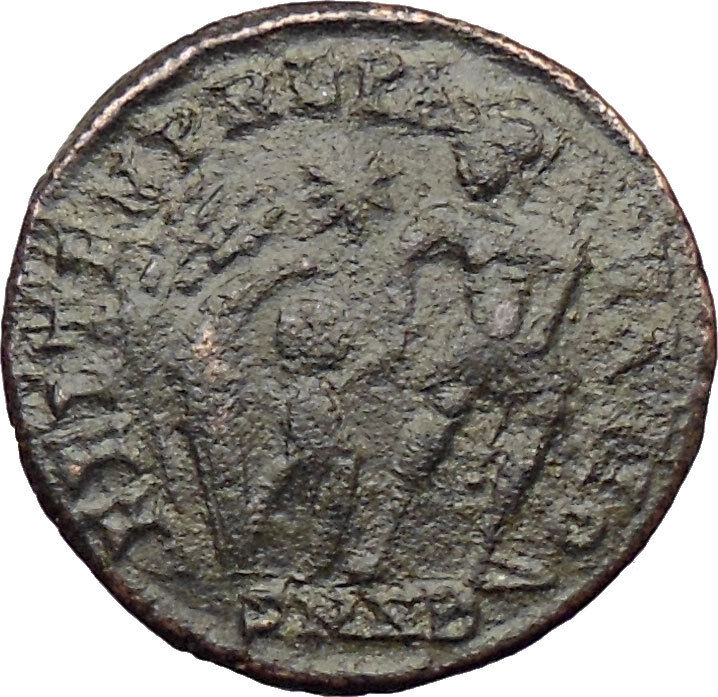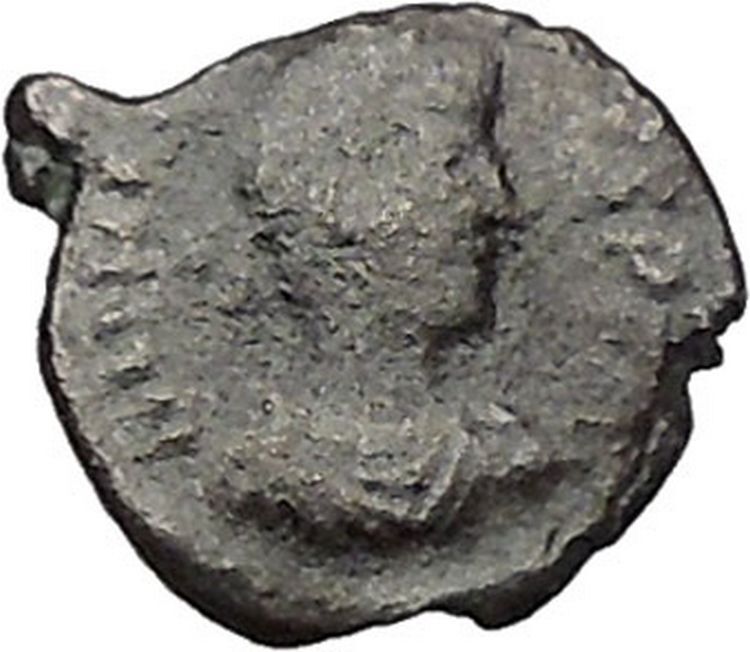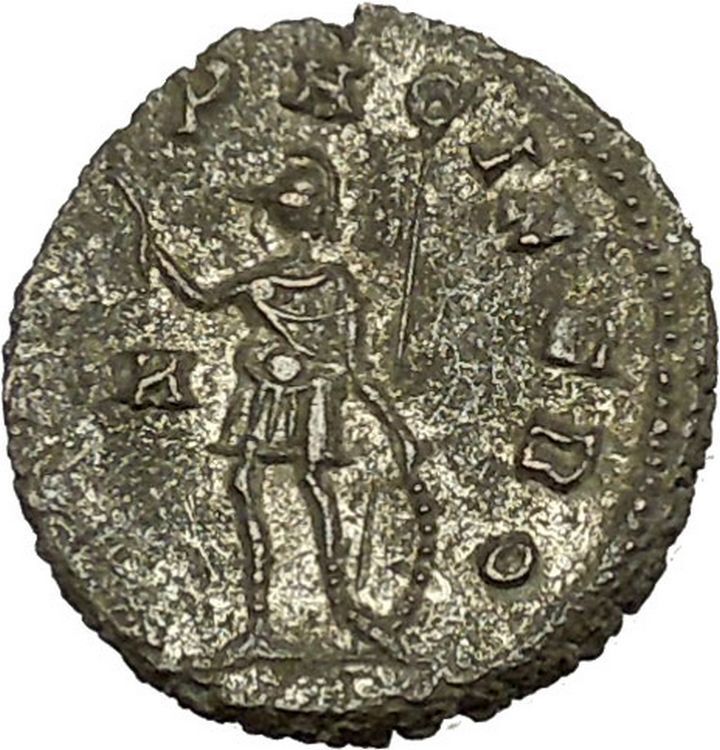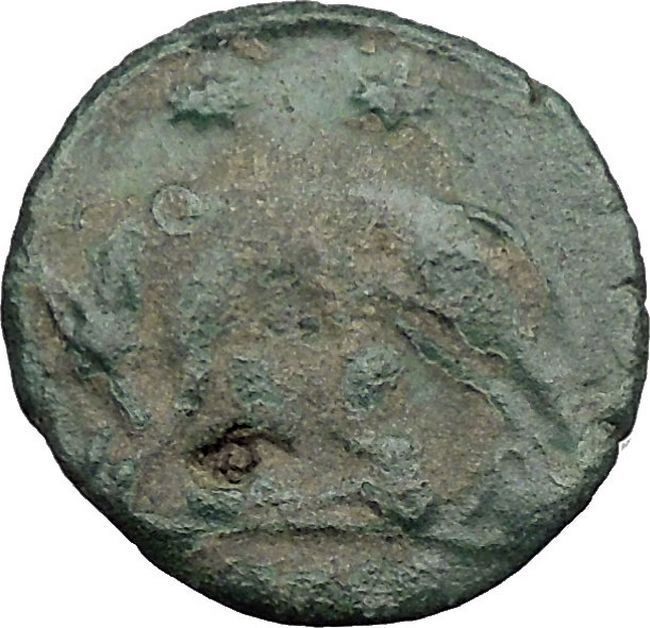|
Julia Mamaea – Augusta: 222-235 A.D.
Silver Denarius 18mm Rome mint, struck 226 A.D.
Reference: RIC 360; RSC 81; BMC 381; Sear 8217
Certification: NGC Ancients Ch VF 4935495-009
IVLIA MAMAEA AVG, Diademed and draped bust of Julia Mamaea to right.
VESTA, Vesta standing front, head to left, holding palladium in her right hand and long scepter in her left.
You are bidding on the exact item pictured, provided with a Certificate of Authenticity and Lifetime Guarantee of Authenticity.
Vesta, one of the great Roman divinities, identical with the Greek Hestia, both in name and import. She was the goddess of the hearth, and therefore inseparably connected with the Penates ; for Aeneas was believed .to have brought the eternal fire of Vesta from Troy, along with the images of the Penates; and the praetors, consuls, and dictators, before entering upon their official functions, sacrificed, not only to the Penates, but also to Vesta at Lavinium. In the ancient Roman house, the hearth was the central part, and around it all the inmates daily assembled for their common meal (coena) ; every meal thus taken was a fresh bond of union and affection among the members of a family, and at the same time an act of worship of Vesta, combined with a sacrifice to her and the Penates. Every dwelling-house therefore was, in some sense, a temple of Vesta ; but a public sanctuary united all the citizens of the state into one large family. This sanctuary stood in the Forum, between the Capitoline and Palatine hills, and not far from the temple of the Penates. The temple was round with a vaulted roof, like the impluvium of private houses, so that there is no reason to regard that form as an imitation of the vault of heaven. The goddess was not represented in her temple by a statue, but the eternal fire burning on her hearth or altar was her living symbol, and was kept up and attended to by the Vestals, her virgin priestesses. As each house, and the city itself, so also the country had its own Vesta, and the latter was worshipped at Lavinium, the metropolis of the Latins, where she was worshipped and received the regular sacrifices at the hands of the highest magistrates. The goddess herself was regarded as chaste and pure like her symbol, the fire ; and the Vestals who kept up the sacred fire were likewise pure maidens. On the 1st of March in every year her sacred fire, and the laurel tree which shaded her hearth, were renewed, and on the 15th of June her temple was cleaned and purified. The dirt was carried into an angiportus behind the temple, which was locked by a gate that no one might enter it. The day on which this took place was a dies nefastus the first half of which was thought to be so inauspicious, that the priestess of Juno was not allowed to comb her hair or to cut her nails, while the second half was very favourable to contracting a marriage or entering upon other important undertakings. A few days before that solemnity, on the 9th of June, the Vestalia was celebrated in honour of the goddess, on which occasion none but women walked to the temple, and that with bare feet.
 In Greek and Roman mythology, the palladium or palladion was a cult image of great antiquity on which the safety of Troy and later Rome was said to depend, the wooden statue (xoanon) of Pallas Athena that Odysseus and Diomedes stole from the citadel of Troy and which was later taken to the future site of Rome by Aeneas. The Roman story is related in Virgil’s Aeneid and other works. This statue, three cubits in height, held a lance in the right hand, a shield on the left arm. Dionysius of Halicarnassus, who follows the Grecian figment that it was the gift if heaven to the Trojans, adds that Aeneas possessed himself of it and conveyed it to Italy, with his household gods (Penates). It was said to have long been preserved in the Temple of Vesta, at Rome and many medals represent that goddess seated, with the Palladium in her hand. In Greek and Roman mythology, the palladium or palladion was a cult image of great antiquity on which the safety of Troy and later Rome was said to depend, the wooden statue (xoanon) of Pallas Athena that Odysseus and Diomedes stole from the citadel of Troy and which was later taken to the future site of Rome by Aeneas. The Roman story is related in Virgil’s Aeneid and other works. This statue, three cubits in height, held a lance in the right hand, a shield on the left arm. Dionysius of Halicarnassus, who follows the Grecian figment that it was the gift if heaven to the Trojans, adds that Aeneas possessed himself of it and conveyed it to Italy, with his household gods (Penates). It was said to have long been preserved in the Temple of Vesta, at Rome and many medals represent that goddess seated, with the Palladium in her hand.
That the Palladium was preserved in the Temple if Vesta, at Rome, is a fact considered by Eckhel, to be typified on a brass medallion of Lucilla, Empress if Lucius Verus, on which, without epigraph, appears a temple, in which is an idol and before which six female figures are sacrificing at a lighted altar. It is narrated by Val. Maximus that, at the burning of the temple of Vesta, Metellus preserved the Palladium, which was snatched unharmed from out of the midst of the conflagration. Lucan, Herodian, and Livy, confirm this statement; the last named writer says – “Quid de asternis Vestae ignibus signoque quod imperii pignus custodia ejus templi tenetur, loquar?” – [“Why need I speak of the eternal fire of Vesta, and of the statue (i.e. Palladium) which is preserved, as a pledge of the empire’s safety, in the sanctuary of her temple?”]
The Palladium borne by Aeneas in his right hand whilst he carries Anchises on his shoulders, appears on coins from the moneyers Cecilia and Julia and on denarii of Julius Caesar. – Minerva also holds it on some imperial medals – It appears in the hand of Juno, on a coin of Julia Soemias. In the hands of Vesta, it is placed, on coins of Vespasian, Titus, Domitian, Trajan, and Antonine; and also on medals of the faustinas and other Empresses. – Also in the hand of Venus, on a coin of Faustina jun. The Palladium also is seen in the right hand of the Genius or Rome, on coins of Vespasian, Domitian, Antoninus Pius and constantius Chlorus. – It also appears in the right hand of Annona, on a silver medal of Titus, as indicating the popular belief that so long as that image was preserved the Roman empire would flourish.
In English, since around 1600, the word palladium has been used figuratively to mean anything believed to provide protection or safety, and in particular in Christian contexts a sacred relic or icon believed to have a protective role in military contexts for a whole city, people or nation. Such beliefs first become prominent in the Eastern church in the period after the reign of the Byzantine Emperor Justinian I, and later spread to the Western church. Palladia were carried in procession around the walls of besieged cities and sometimes carried into battle.
Julia Mamaea – Augusta: 222-235 A.D.
| Mother of Severus Alexander | Daughter of Julia Maesa | Mother-in-law of Orbiana | Sister of Julia Soaemias | Nice of Julia Domna and Septimius Severus | Aunt of Elagabalus | Cousin of Caracalla and Geta |

Julia Avita Mamaea (14 or 29 August after 180-235) was the second daughter of Julia Maesa, a powerful Roman woman of Syrian Arab origin and Syrian noble Julius Avitus. She was a niece of empress Julia Domna and emperor Septimius Severus and sister of Julia Soaemias. She was born and raised in Emesa (modern Homs, Syria).
Julia’s first husband was a former consul (whose name is unknown) who died. Julia married as her second husband Syrian Promagistrate Marcus Julius Gessius Marcianus. Julia bore Marcianus two children, a daughter called Theoclia (little is known of her) and a son, Marcus Julius Gessius Bassianus Alexianus, later emperor Alexander Severus. Unlike her sister, Julia Mamaea was reported to be a virtuous woman, never involved in scandals.
As a member of the Imperial Roman family, she watched closely the death of her cousin Caracalla and the ascent to power of her nephew Elagabalus, the oldest grandson of Julia Maesa and her choice to the throne. Eventually Elagabalus and his mother Julia Soaemias proved incompetent rulers and favour fell on Alexander, Julia’s son. He became emperor in 222, following Elagabalus’ murder by the Praetorian Guard. Julia and her mother became regents in the name of Alexander, then 14 years old. Upon adulthood, Alexander confirmed his esteem for his mother and named her consors imperii (imperial consort). It was in this condition that she accompanied her son in his campaigns: a custom started with Julia Domna. Thus she travelled to the East, for the campaign against Parthia and to the Germania provinces. Julia Mamaea was with Alexander in Moguntiacum (modern Mainz), capital of Germania Superior, when he was assassinated by his troops. She suffered the same fate.
|









 In Greek and Roman mythology, the palladium or palladion was a cult image of great antiquity on which the safety of Troy and later Rome was said to depend, the wooden statue (xoanon) of Pallas Athena that Odysseus and Diomedes stole from the citadel of Troy and which was later taken to the future site of Rome by Aeneas. The Roman story is related in Virgil’s Aeneid and other works. This statue, three cubits in height, held a lance in the right hand, a shield on the left arm. Dionysius of Halicarnassus, who follows the Grecian figment that it was the gift if heaven to the Trojans, adds that Aeneas possessed himself of it and conveyed it to Italy, with his household gods (Penates). It was said to have long been preserved in the Temple of Vesta, at Rome and many medals represent that goddess seated, with the Palladium in her hand.
In Greek and Roman mythology, the palladium or palladion was a cult image of great antiquity on which the safety of Troy and later Rome was said to depend, the wooden statue (xoanon) of Pallas Athena that Odysseus and Diomedes stole from the citadel of Troy and which was later taken to the future site of Rome by Aeneas. The Roman story is related in Virgil’s Aeneid and other works. This statue, three cubits in height, held a lance in the right hand, a shield on the left arm. Dionysius of Halicarnassus, who follows the Grecian figment that it was the gift if heaven to the Trojans, adds that Aeneas possessed himself of it and conveyed it to Italy, with his household gods (Penates). It was said to have long been preserved in the Temple of Vesta, at Rome and many medals represent that goddess seated, with the Palladium in her hand.





